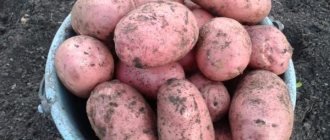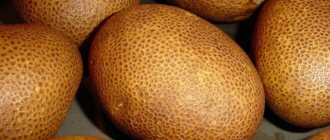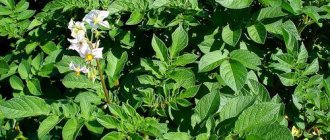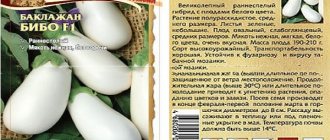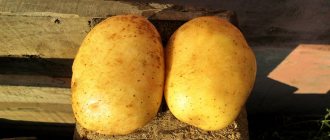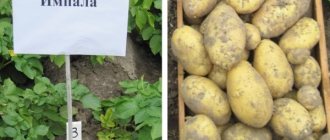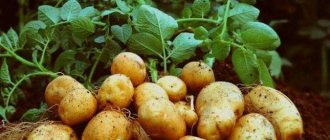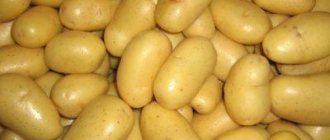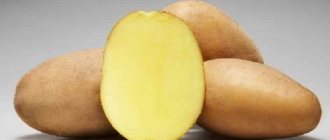Description of the variety
This is a mid-late variety. Depending on the climate and region, the growing season of Lasunok potatoes can be from 80 to 100 or from 100 to 120 days.
Escapes
The bushes of this potato variety grow up to 1 meter. The tops are strong, powerful, the stems are thick. The leaves are also rough and thick, covered with hard down. During flowering, the bushes are covered with white inflorescences. Even with a 70x40 potato planting scheme, weeds have no chance of getting through the tightly packed Lasunka bushes. And this has another plus - moisture is retained so well, which is especially important for arid regions.
Roots
Potatoes of this variety are oval-round and large in size, the weight of each root crop is about 200 grams. The peel can be light yellow to light brown. The eyes on potatoes are small in size. The potatoes themselves are cream colored.
Potatoes are well boiled, the starch content in them is from 16 to 22%. Thanks to this property, Lasunok is well suited for making mashed potatoes, potato chips, starch and French fries.
Characteristics of Lasunok potatoes
Lasunok belongs to the high-yielding mid-late or late-ripening potato varieties, depending on the region of planting. It has excellent taste, is suitable for preparing various dishes, is stored quite well, does not require special care, and is resistant to diseases and pests.
General characteristics of potatoes of the Lasunok variety:
- The bush is tall, erect, multi-stemmed. The stem is thick and fleshy. The leaves are dark green, covered with hard fibers, which provides protection from the Colorado potato beetle.
- The tubers are large, oval-shaped, the pulp is white-yellow, the peel is yellowish, light. The eyes are sparse and deep-set, but this does not interfere with germination. In spring they “wake up” early. The average weight of tubers is 120 – 180 g. Particularly large fruits reach 200 g.
- Flowering is abundant, long lasting, flowers are white with a yellow center.
- The ripening period is 90 – 120 days, depending on the region of cultivation, care, and weather conditions.
- Productivity: on average 10 - 12 tubers per bush, under favorable conditions - up to 15 - 17.
- Keeping quality is average; if the recommended temperature is not observed, the tubers begin to actively germinate.
The variety is recommended for cultivation in the Central, North Caucasus, Far Eastern, Volga-Vyatka regions of Russia. Due to its high yield, unpretentiousness, and disease resistance, it is suitable for large agricultural enterprises and small garden plots.
Important! Lasunok potatoes do not tolerate heat and drought well. When growing in the southern regions, it is necessary to monitor the timeliness and volume of watering.
From the photo you can evaluate the characteristics of the Lasunok potato variety.
Characteristics and features of the variety
Lasunka is considered the most delicious potato of all varieties of Belarusian selection. However, its taste depends on the type of soil in which it is grown. Thus, potatoes that grew on sandy soil have the best taste.
Let's take a closer look at this variety:
- An important feature of this potato is its high resistance to diseases such as tuber late blight, cancer, viruses S, M, Y, L. As well as average resistance to diseases: rhizoctonia, black leg and scab.
- The potato harvest is harvested 3-4 months (depending on the region) after the first shoots appear.
- Flowering takes a long time.
- Lasunok produces a large harvest. Up to 62 tons of potatoes are harvested from one hectare of land. There are usually from 8 to 11 tubers under one bush.
- Potatoes germinate at temperatures of 5-7 degrees above zero.
- Any type of soil is suitable for growing this potato variety. Lasunok is unpretentious in this regard.
Potatoes that are not damaged by the Colorado potato beetle
POTATO VARIETIES THAT ARE NOT DAMAGED BY THE COLORADO BEETLE
There are about 4 thousand varieties of potatoes in the world today. And among these four thousand varieties, there are only 7 varieties that are practically not damaged by the Colorado potato beetle. Only seven!
The leaves of these varieties have hard pubescence, which is why the Colorado potato beetle does not like it, and it avoids these plants. Elite potato tubers, small size (mini tubers).
When creating potato varieties Utro, Lasunok, Bryansky Reliable, and Kamensky resistant to Colorado potato, no genetic modification methods were used. These varieties and hybrids are obtained using methods that go back several thousand years. How convenient such varieties are is no need to tell.
This is a real salvation for gardeners who prefer to grow potatoes (rather than buy them at the market). And for summer residents who plant few potatoes, but who simply don’t have time to collect Colorado potato larvae. It must be said that these 4 varieties of potatoes are also good in themselves - they are tasty, productive, excellent varieties of potatoes. The seeds of these potatoes are in the photo – elite tubers, small in size (mini-tubers), but they already produce full-fledged bushes.
Potatoes Bryansk reliable
Russian new variety, with very good taste, resistance to the Colorado potato beetle, scab
, excellent keeping quality. 5 packages with elite potato tubers - updating varieties. The tubers are round, up to 10 pieces under each bush, red with colored eyes, white flesh.
The plants are tall and the flowers are red-violet. The taste of potatoes is excellent, the accumulation of starch is high.
Potato Lasunok
A Belarusian potato variety that is unsurpassed in taste. Varieties of potatoes and family onions. Plants are powerful, with abundant, long-lasting, pure white flowering, high yield. Suitable for growing on all types of soil.
The tubers are large, leveled, the variety is distinguished by early tuberization and intensive growth. The tubers are round-oval, the skin is yellow, mesh, the mass of the tuber is about 150–200 g, the quantity is up to 12 pieces per plant. The tubers are boiled, have excellent taste, and the flesh does not darken.
In terms of taste, Lasunok is a leader among the ten most delicious domestic and foreign potato varieties
. Plus, it is not affected by late blight and viruses, and is not at all affected by the Colorado potato beetle. Rigid pubescence of leaves - they are inedible for Colorado.
Potatoes Kamensky
Potatoes that are not damaged by the Colorado potato beetle. A new product of the Ural selection, deserving the highest rating in many respects. One of the few varieties resistant to the Colorado potato beetle.
The beetle does not like powerful, upright plants with large, hard leaves. The variety produces an excellent harvest of tasty, elongated oval, red tubers, with a slightly mesh skin and light yellow inside.
Potato Morning
Not every gardener can come to his garden plot at any time to ensure timely watering for all plants. You can forget about this problem with the Morning potato variety, because drought resistance is its main feature.
The resistance of this variety to the Colorado potato beetle is simply fantastic. An excellent variety, very easy to grow. Late blight and scab are also not at all scary for the variety. The tubers are bright red, with bright yellow flesh, very delicate taste, crumbly when boiled.
Resistance to late blight of leaves: 5 Resistance to late blight of tubers: 6 Region: 2 (North-Western), 3 (Central), 4 (Volga-Vyatka), 5 (Central Black Earth), 6 (North Caucasus) Ripening period: 7 (Late )
Description
The plant is erect, tall, and the flowers are white. The tubers are round-oval in shape, large, light yellow skin, creamy flesh, eyes of medium depth.
The yield is high, the dormancy period is short, the keeping quality is satisfactory and good, the starch content is 15-22%, the taste is good and excellent. Moderately susceptible to late blight on tops and moderately resistant to tubers.
According to the originator, it is resistant to cancer, viruses “S”, “M”, “U”, “L”, scab, rhizoctonia, blackleg, susceptible to virus “X”. Value of the variety: high yield, resistance to late blight, viruses, suitability for the production of dry mashed potatoes, chips, frozen potatoes, alcohol and starch.
We and the entire farming community will be grateful if you send us your video or link about this variety from YouTube or any other video hosting service. If you see this message, it means that we have not yet been able to find a suitable video for this variety.
Where can you grow Lasunok?
Since the variety is unpretentious, it grows well in almost all areas. If we consider post-Soviet lands, then they are good for growing:
- Central District;
- North Caucasian;
- Far Eastern;
- Central Black Earth;
- Northwestern;
- Belarus;
- Polesie;
- Transcarpathia.
Pros and cons of culture
Before planting potatoes, you should become familiar with their strengths and weaknesses. Negative aspects can be considered insignificant.
| pros | Minuses |
| High yield, large tubers | Short dormant period, in spring, tubers germinate quickly |
| Low maintenance, easy to grow | The structure of the fruit is loose; after exposure to temperature, the vegetable becomes too crumbly |
| High immunity to plant diseases | |
| Resistance to harmful bugs | |
| Excellent table quality |
Advantages and disadvantages of the variety
This variety has many advantages over others:
- high productivity;
- resistance to pests, especially the Colorado potato beetle, which spoils most potato varieties;
- pleasant taste;
- high immunity that protects against fungi and viruses.
But besides the advantages, Lasunok also has some disadvantages:
- the harvested crop is not stored for very long;
- Potatoes are soft, so they are more suitable only for boiling. There will be no crispy crust when frying;
- unstable to bad weather conditions: extreme heat and lack of water have a bad effect on the quality and quantity of the crop.
Taste qualities of potatoes
The Lasunok potato variety, bred by Belarusian breeders, has been known in Russia since 1988. Due to its taste characteristics and versatility, it quickly became widespread and popular.
Potatoes have a delicate, creamy taste. At home, it is used for purees, potato pancakes, casseroles, first courses, and vegetable stews. On an industrial scale, it is processed into chips, starch, and included in frozen mixtures.
Important! Potatoes of the Lasunok variety retain their taste after defrosting.
After heat treatment, the tubers become loose, easily boil, crumble, but do not lose their attractive appearance and color.
How to plant potatoes
You can start planting potatoes when the soil warms up. At a depth of 10 cm, its temperature should be +7 degrees. This usually happens in late April - early May. It is advisable to start planting in the morning.
In order to get a good harvest, you need to choose the right place to plant potatoes.
Depending on the soil the plant will be in, you need to choose the planting depth. So, on sandy loam, tubers should be planted to a depth of 10-12 cm, and on loam - 5-7.
The landing site should be level and well lit. It is important to remember that you cannot plant potatoes in one place often, as the soil there will lose its nutrients. The planting site should be changed every 4 years. It is useful to plant potatoes in the place where leguminous or winter crops grew before them.
This method also has a good effect on the harvest: after harvesting in the fall, plant watercress in its place. It grows quickly and nourishes the soil, which is good for the next potato crop.
Soil preparation
The soil surface must be level. You need to start preparing the site in the fall. It should be plowed and fertilized; manure is best; it has a good effect on the quality of the crop.
Before planting potatoes, the soil must be loosened and weeds removed.
It is also possible, but not necessary, to mulch potatoes for the following purposes:
- to protect against frost;
- for uniform distribution of water;
- to protect potatoes from weeds;
- for heat distribution.
Mulching is carried out before planting potatoes. First, you should remove the weeds, then moisten and loosen the soil, apply fertilizer and leave for several days to ventilate.
When mulched with straw, potatoes are well protected from cold and drought. To carry out the procedure, it is necessary to loosen the soil and make furrows, leaving about half a meter between them. The tubers should be placed in them at a distance of 30 cm, and then covered with a 20 cm layer of mulch. After the sprouts reach 6 cm in height, you need to cover the potatoes with another 15 cm layer of straw.
Preparation of planting material
Tubers need to start being prepared for planting 4 weeks in advance to get a good harvest. To do this, they need to be taken out of storage and germinated. The tubers will warm up after cold storage for a couple of days, and after 2-3 weeks sprouts will appear.
Before planting, you can divide each potato into parts, but each of them must have a sprouted “eye”. Even from small slices of tubers (at least 50 g) large potatoes will grow.
To get more sprouts and it happens faster, you can use special methods, wet or dry:
- When wet, the tubers should be stored in humus or sawdust, the temperature should be about 15 degrees. With this method, planting material begins to grow very quickly after planting in the soil.
- With the dry method, the tubers are stored in boxes in the light. This causes the potato skins to turn green. Please note that such potatoes are not suitable for eating, but are good for planting, because with such preparation they will be less likely to suffer from insects and diseases.
Planting scheme
When planting Lasunka potatoes, the depth of each hole should be 8-10 cm on sandy loam soil and 6-7 on loam. Before planting the tubers, you should fill the holes with wood ash or humus - half a kilogram. The tuber planting pattern is 70 by 40 cm.
Potato care
The Lasunok variety does not require special care. It only needs to be watered, fertilized, hilled and weeded on time.
Watering
There is no need to water the potatoes for the first time after planting: during this period the plant’s roots are just forming. After this, Lasunok should be watered with plenty of water, but not often. During the entire growth period, there should be at least three waterings. Potatoes should be watered during flowering and on very hot days. The best time for watering is morning.
Feeding
Lasunok needs nitrogen fertilizers so that there is not too much greenery and the potatoes develop well. The fact is that when the bushes are too dense, then all the useful substances from the soil go to maintaining the greenery, and not the root crops. As a result, the potatoes remain small.
During the growing season, Lasunok should be fertilized with fertilizers containing phosphorus and potassium. Diammofoska or Nitrophos, as well as mullein, are well suited for this. In total, about 3 feedings are enough for the entire period.
Loosening and weeding
Loosening helps the roots receive enough oxygen and moisture. This procedure should be carried out for the first time a week after planting the potatoes, and at the same time all weeds should be removed. Loosening should be carried out regularly until the hilling period.
Hilling
The first hilling is carried out when the height of the bush is 10 centimeters. During this procedure, you should rake the soil that is between the rows to the trunks of the bushes and sprinkle them on all sides. Hilling should be done every 2-3 weeks.
We invite you to watch in more detail about why you need to hill up potatoes and how to do it correctly in the video clip:
Features of cultivation
When growing Lasunok potatoes, special attention is paid to care. Plantings are watered and fed
Periodically, the bushes are hilled up and the beds are cleared of weeds.
Watering schedule
According to its characteristics, Lasunok potatoes are sensitive to drought. Potatoes are not watered until buds form. Then the soil is kept moist, preventing it from drying out. Moisture is added in the evening, when there is no direct exposure to the sun. The watering rate per bush is up to 3 liters. During drought, plantings are watered 3-5 times during the season.
Advice! Do not water potatoes with cold water from a hose. The moisture must first sit in the barrels in the sun.
Loosening, weeding, hilling
Hilling is a mandatory stage of crop care. Under the base of the bush, soil is raked from between the rows. As a result, the bush becomes more compact, and new tubers are formed in the aboveground part.
Important! When hilling potatoes, the soil is loosened to saturate it with oxygen. In loose soil, tubers better absorb moisture and nutrients
The Lasunok variety is hilled twice per season. The first treatment is carried out when the shoots grow to 15 cm, the next – after 3 weeks. It is best to hill up bushes after watering or precipitation.
Do I need to feed
According to the characteristics and photos of gardeners, Lasunok potatoes react positively to fertilizing
Use nitrogen fertilizers with caution: urea, slurry, chicken droppings. They are used only at the beginning of the growing season
Excess nitrogen leads to green growth, which negatively affects the volume of the harvest.
Complex fertilizers are prepared for Lasunok potatoes. To 15 liters of water add 20 g of superphosphate, 10 g of potassium salt and 30 g of wood ash. This fertilizer is applied before and after the appearance of buds. Consumption per bush is 1 liter.
Protection from diseases and pests
Lasunok potatoes have high immunity. It is resistant to diseases such as late blight, cancer, blackleg, verticillium wilt, scab, alternaria, fusarium and other diseases and viruses. In addition, the Colorado potato beetle does not harm this variety.
However, Lasunok may suffer from a pest such as wireworm. To prevent its occurrence, preventive measures can be taken even before planting potatoes. Since the wireworm can greatly spoil the harvest, we advise you to bury plastic cups with potato peels in the ground throughout the entire area a week before planting the tubers. After 3 days, wireworm larvae will collect in them. The procedure can be repeated again as needed.
Features of care
Despite its unpretentiousness, only timely and proper care of the Lasunok variety of potatoes contributes to obtaining good yields of this vegetable crop. A set of basic care measures should be based on climatic conditions, soil fertility indicators, and also take into account the development phase of the vegetable crop:
If there is severe contamination of the soil with weeds, then weeding and loosening of the rows must be carried out even before the potato shoots appear, but with extreme caution so as not to damage the sprouts of the vegetable crop. After the potato seedlings reach a height of 10–12 cm, it is important to carry out the mandatory first hilling, which stimulates the appearance of additional stolons on the plant; The optimal depth for hilling potato seedlings on light soils is 13–15 cm, and hilling on heavy soil should reach 10–12 cm.
- In the first days after planting, it is not recommended to water potatoes, since during this period the root system of the plant is formed, and then there should be approximately three main irrigations for the entire growing period.
- After the emergence of potato shoots, it is recommended to fertilize the vegetable crop with good water-soluble nitrogen and potassium fertilizers; It is allowed to fertilize with mullein or any other nitrogen-containing fertilizer, as well as urea at the first stage of development, and then use highly effective foliar fertilizing.
Harvest and storage
Harvesting occurs at the end of summer - beginning of autumn. To do this, you can use special devices or assemble it manually.
Before harvesting the crop for storage, it should be allowed to dry in the fresh air. Then you need to remove the damaged potatoes, and put the good ones in wooden boxes and store them in a place where the air temperature is about +2 degrees, for example, in the basement. Air humidity should be approximately 70%. Such storage conditions will help preserve the harvest until spring.
The Lasunok potato variety has remained at the peak of popularity among gardeners for many years. And for good reason, because it is easy to grow, it does not require complex care and copes with diseases and resists pests without additional effort. In addition, this variety has a pleasant taste.
0
0
Copy link
Landing
Potatoes can be grown from tubers or seeds. The seed method is suitable when it is necessary to update the variety to avoid degeneration. It is better to do this once every five years. Seeds are purchased from a trusted company or collected independently from berries that ripen on the bushes in the fall. You should work with berries while wearing gloves.
From bushes grown by seedlings, small seed tubers are obtained in the first season. The prepared fruits are sorted, making sure that there are no rotten or damaged ones among them. Lay them out in a thin layer in a well-lit place. The optimal temperature is +12-15 degrees, but Lasunok tends to germinate already at +5-7.
By the time of planting, the length of the sprouts should be 2-3 cm, and the soil temperature should not fall below +12.
The variety can be planted in fragments rather than as whole tubers.
Lasunok potatoes are unpretentious to soils, but are more productive on sandy loam and chernozem soils. Prepare the area like this:
- Choose a sunny place after cucumbers, zucchini, legumes, pumpkins, cabbage, radishes, radishes, onions, garlic, and various greens.
- In the fall, the site is dug up to the depth of a spade and organic fertilizers are applied.
- In the spring, add a little mineral fertilizer and dig again, maybe not so deep;
- Heavy soil is diluted with sand and peat.
- Too acidic soil is deoxidized with dolomite flour, slaked lime, and ash.
The variety does not like excess fertilizer. If the soil is not depleted, they are added a little and with caution.
Leave 45-50 cm between bushes, 70-90 cm between rows.
Disembarkation
Lasunok potatoes must be planted in the ground when the ground has warmed up by at least 10 cm. This period can be determined by the blossoming leaves on the birch tree. When they reach the size of a penny, the tubers can be planted.
It is better to make the distance between the rows at least 90 cm. In this case, the bushes will be well ventilated and the likelihood of late blight will decrease. Yes, and hilling such rows will be much easier and more convenient.
If you have to cut the seed, the knife must be periodically disinfected in a manganese solution to avoid damaging healthy tubers with various diseases.
Origin story
The “Lasunok” variety is the result of selection by employees of the “Scientific and Practical Center of the National Academy of Sciences of Belarus for Potato and Fruit and Vegetable Growing.”
Registered in the State Register of Russia and the Republic of Belarus in 1988.
The table presents data on the mass of marketable tubers (grams) of different varieties:
| Name | Variety | Weight |
| Nikulinsky | Late ripening | From 70 to 120 |
| Cardinal | Late ripening | 65-110 |
| Rocco | Late ripening | 100-120 |
| Picasso | Late ripening | 80-140 |
| Borovichok | Early ripening | 120-200 |
| Elmundo | Early ripening | 120 |
| Felox | Early ripening | From 100 to 120 |
| Bellarosa | Early ripening | From 120 to 210 |
| Karatop | Extra early | From 58 to 100 |
| Zhukovsky early | Extra early | 100 to 120 |
| Farmer | Extra early | From 90 to 110 |
| Minerva | Extra early | From 120 to 245 |
| Sorcerer | Mid-late | From 75 to 120 |
| Mozart | Mid-late | From 100 to 150 |
| Grenada | Mid-late | From 800 to 100 |
| Melody | Mid-late | From 95 to 180 |
| Giant | Mid-early | 100-140 |
| Tuscany | Mid-early | From 90 to 125 |
| Purple Haze | Mid-early | From 90 to 160 |
| Openwork | Mid-early | 90-120 |
Five regions are suitable for cultivation:
- Central;
- Northwestern;
- North Caucasian;
- Volgo-Vyatsky;
- Central black earth.
Vitamins in potatoes
This vegetable was first grown in America. Over time, thanks to its valuable taste, it became popular all over the world. It contains as much vitamin C as one citrus fruit. The bulk of this vitamin is found in potato peels. You just need to follow the cooking technology.
Tubers contain a sufficient amount of potassium, which is important for normal heart function, metabolism and maintaining water balance in the body. Scientists have found that potatoes are a kind of adsorbent and remove toxic substances. Therefore, in case of poisoning of various types, it is often allowed to eat it.
Potatoes help reduce the nervous load on the body and reduce the incidence of depressive conditions. Juice from a raw vegetable will help get rid of headaches, heartburn and provide various vitamins A and B.
The vegetable also contains many minerals, on which the proper functioning of all body systems depends:
- phosphorus;
- calcium;
- boron;
- magnesium;
- fluorine, etc.
Vitamins in potatoes can replace the daily need for them during a poor diet or during a diet.
